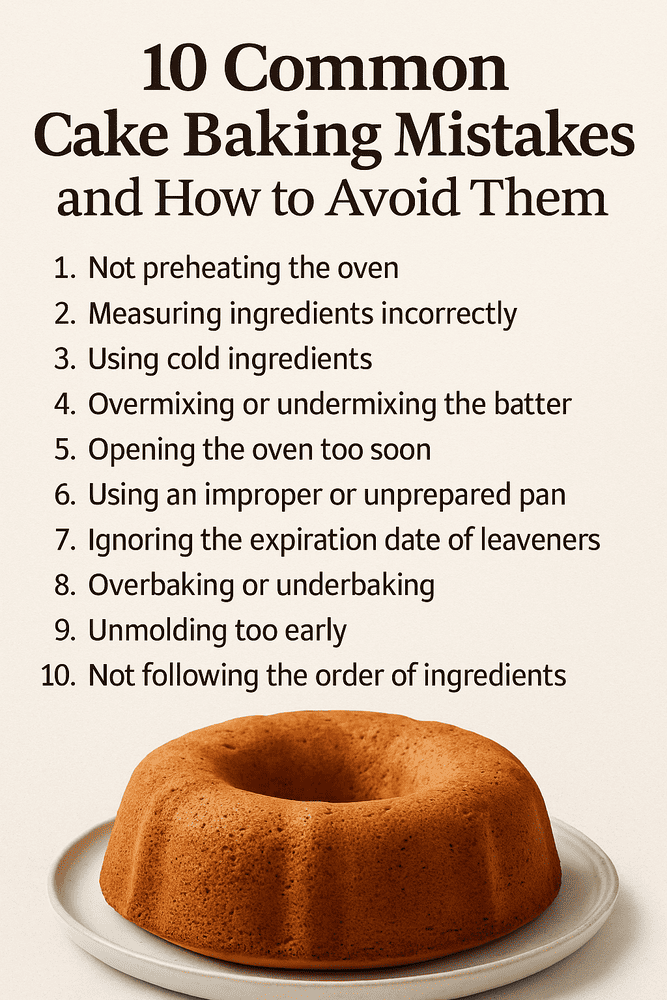Baking cakes can be incredibly rewarding—but it’s also easy to make mistakes along the way. Even simple recipes can go wrong if you’re not careful with the details. In this article, you’ll learn the 10 most common mistakes when baking cakes and, most importantly, how to avoid them. If your cake has ever turned out dry, flat, sticky, or tasteless, this guide will help you troubleshoot and improve. By understanding what causes each problem, you’ll gain more control over your baking results and take your skills to the next level. Tip: This article is a great follow-up to “How to Make Your First Cake from Scratch” (Article #1).
1. Not Preheating the Oven
This is one of the most frequent beginner mistakes. Baking powder (or soda) needs immediate heat to activate and make the cake rise properly. What can go wrong: sunken, dense, or underbaked cake. How to fix it: Always preheat your oven for at least 10–15 minutes before putting the cake in. Use an oven thermometer for accuracy.
2. Measuring Ingredients Incorrectly
Baking is a science. Even a small difference in flour or sugar can drastically affect the result. What can go wrong: dry, tough, or poorly structured cakes. How to fix it: Use standard measuring cups and spoons. Don’t estimate or scoop flour directly—spoon it into the cup and level with a knife.
3. Using Cold Ingredients
Cold eggs, milk, or butter don’t blend well and can mess up your batter. What can go wrong: curdled batter, uneven rise, lumpy texture. How to fix it: Let ingredients sit at room temperature for 30 minutes. If you’re in a rush, place eggs in warm water for a few minutes and slightly soften butter in the microwave.
4. Overmixing or Undermixing the Batter
Too much or too little mixing both lead to problems. What can go wrong: dense cake (from overmixing) or uneven texture (from undermixing). How to fix it: Mix just until ingredients are combined and smooth. If using a mixer, stick to low speed and keep an eye on the batter’s texture.
5. Opening the Oven Too Early
It’s tempting to peek, but opening the oven before the cake has set can cause it to collapse. What can go wrong: flat, uncooked, or cracked cakes. How to fix it: Wait at least 30 minutes before opening the oven door. Only open when testing with a toothpick near the end of the baking time.
6. Using an Improper or Unprepared Pan
Pan size and prep matter more than you think. What can go wrong: cakes that stick, burn, or overflow. How to fix it: Use the type and size of pan recommended in the recipe. Always grease and flour it well, or use parchment paper. Don’t fill it more than 2/3 full.
7. Ignoring the Expiration Date of Leaveners
Old baking powder or soda won’t do their job. What can go wrong: cake doesn’t rise properly or stays dense. How to fix it: Check expiration dates. You can test freshness by adding a teaspoon to warm water—it should bubble immediately.
8. Overbaking or Underbaking
Baking time varies with oven type, pan, and recipe. What can go wrong: dry, burnt, or raw cake. How to fix it: Use baking time as a guide, not a rule. Always test with a toothpick—it should come out clean or with a few dry crumbs.
9. Unmolding Too Early
Patience is key! What can go wrong: cake falls apart or sticks to the pan. How to fix it: Let the cake rest in the pan for 10–15 minutes after baking. Then gently loosen the edges and unmold onto a rack to cool completely.
10. Not Following the Mixing Order
The sequence of mixing affects texture and structure. What can go wrong: batter separation, poor rise, gummy texture. How to fix it: Follow the order in the recipe—typically creaming butter and sugar, then eggs, then alternating dry and wet ingredients.
✅ Quick Recap:
| Mistake | Solution |
|---|---|
| Cold oven | Preheat properly |
| Wrong measurements | Use accurate tools |
| Cold ingredients | Bring to room temp |
| Overmixing | Mix only until combined |
| Opening oven early | Wait at least 30 minutes |
| Pan issues | Prep and size correctly |
| Expired leaveners | Test freshness |
| Over/underbaking | Use toothpick test |
| Unmolding too fast | Wait before releasing |
| Wrong order | Follow recipe steps |
Final Thoughts
Mistakes are part of the learning process—but with knowledge, they become less frequent. Use this list as a reference whenever you bake and you’ll quickly notice improvement in your results. Practice makes perfect. And every cake you bake brings you closer to mastering the art!
Keep Exploring:
- How to Make a Sponge Cake That Never Fails
- Understanding the Role of Eggs in Cake Baking
- How to Make a Chocolate Cake That Melts in Your Mouth
